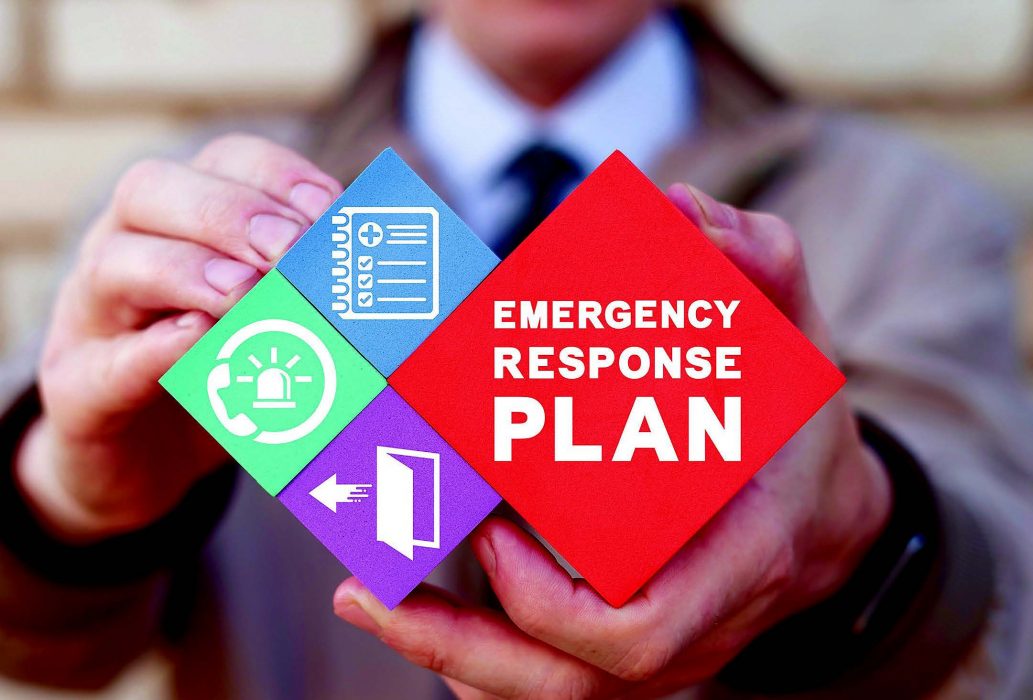
By Jim Mattes, originally published in SBAM’s May/June 2023 issue of Focus magazine
While the likelihood of having to execute an emergency action plan is low, it’s certainly not zero. Everyone remembers evacuating the building when schools would have fire drills. The same fundamental principals apply to any workforce needing to evacuate a building.
Generally speaking, many organizations have an emergency preparedness plan in place, but does everyone know what to do if something actually occurs? Without the proper training and practice, when an alarm is triggered, the first thing everyone does is panic, and rightfully so. Here we will discuss some of the measures your organization can take to be as prepared as possible, if you encounter an emergency scenario.
Maps and Alarm Systems
For starters every building should have evacuation maps posted throughout the facility to educate employees and visitors on the location of fire extinguishers, emergency exits, tornado shelters and proper pathways throughout a building. If you currently do not have evacuation maps, this is something you should prioritize right away. Once the map is in place, it is important that everyone understands where they should go based on what type of emergency occurs.
Everyone always thinks they should evacuate the building at the sign of an alarm. But you should also make sure your employees know when to exit or when to, instead, take shelter. We don’t want people hearing what they think is a fire alarm and heading outside, when in fact, it is a take shelter alarm. There is no “standard alarm” noise that everyone can recognize and automatically know what emergency situation is happening, so you need to put in place something that indicates what type of alarm it is. In most scenarios vibrating bells indicate a fire alarm, whereas alarms that sound more like horns are used to call a critical situation to attention. Paging systems can distinctly describe the emergency at hand, which results in the promptest response by individuals for the type of scenario.
In some facilities there are excessively loud, additional measures that need to be taken to notify those who might not hear the alarm. And some facilities are not equipped with emergency alarms, and organizations need to determine another method of notification. Something as simple as an air horn can be used, or visual alarms can play a factor in catching employees’ attention.
Practice to Ensure Readiness
As an organization you should practice your emergency preparedness plan at least once a year. However, when you practice your plan, it should not just be pulling the alarm then everyone exiting the building. You should also involve your local fire department so they know you are performing a drill and can help expedite the process.
During the drill, assess the situation and make note of how long it takes to get everyone out of the building. You should also take note of how long it takes the fire department to arrive onsite. Everything mentioned here should be documented—what went well and what did not go well?
Also, how are you ensuring everyone in the building is accounted for? This not only includes employees, but visitors in the building as well. Documenting everything creates a record and allows you to review areas of concern when practicing a drill the next year. Practice makes perfect, and that documentation helps you identify and understand any issues that occurred, preventing you from running into those same issues in a real emergency.
Assign Leaders and Meeting Points
It is recommended to create emergency preparedness leaders who are responsible for making sure everyone on their team is out of the building, similar to a teacher taking a head count for every student in their classroom. Depending on where you spend most of your time in your facility, there should be a designated path you can take and a designated muster or meeting point for you to congregate. Keeping track of visitors and their last known location will also aid in quickly accounting for all individuals inside the facility.
Violence in the Workplace
Another component organizations need to consider is emergency preparedness in case of a workplace violence incident. One of the best controls you can put into place when it comes to workplace violence is controlling your entrances and exits. Employees tend to leave doors open, which can result in anyone walking into your building. By not leaving doors propped open, you can ensure that no one enters without at least checking in with someone prior. In theory, you should never let someone in your building unattended without a scheduled appointment.
What can you do about workplace violence between employees? As a supervisor or team leader, it is important to monitor social interactions between employees you oversee. If you find two employees arguing repeatedly, this could be an indication of future altercations. Advise your peers to keep an eye on their interactions and to notify someone if matters seem to worsen.
Be Fully Prepared
Depending on the type of facility you operate, there are other additional safety measures to consider, such as a response to a chemical spill, utility failure or medical emergency. Employers should also make accommodations for non-English speaking employees and workers with disabilities.
Having a clearly established chain of command and training associated with your emergency plan will be the one thing that can help prepare an organization the most. At the end of the day, you always hope your organization never has to deal with an emergency. But in case you do, having a practiced and established plan can potentially save lives.